The third-generation Apple iPad is here, and we've tested it next to our best Android tablets--the Asus Transformer Prime TF201 and the Samsung Galaxy Tab 10.1. While our tests of battery life and recharge times are still pending, a clear picture of this latest iPad is emerging. Put simply: The new iPad streaks to the head of the pack, largely on the strength of improvements to its display. But this doesn't mean that everyone else should abandon the race; it just means that they're going to have to work harder to overcome the iPad's lead.
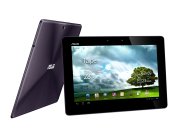 In the comparison I'll be making here, I focus on the new iPad, the older iPad 2, and three recent and highly ranked 10.1-inch Android challengers: the Asus Eee Pad Transformer Prime TF201, the Samsung Galaxy Tab 10.1 (for this review, we tested the 4G LTE version), and the Toshiba Excite 10 LE (formerly known as the Excite X10)--the thinnest and lightest tablet on the market, and one so new that it's still making its way through our testing. All three Android models here have 1280-by-800-pixel resolution, which means that their pixels-per-inch spec beats the iPad 2's, 150 ppi to 132 ppi.
In the comparison I'll be making here, I focus on the new iPad, the older iPad 2, and three recent and highly ranked 10.1-inch Android challengers: the Asus Eee Pad Transformer Prime TF201, the Samsung Galaxy Tab 10.1 (for this review, we tested the 4G LTE version), and the Toshiba Excite 10 LE (formerly known as the Excite X10)--the thinnest and lightest tablet on the market, and one so new that it's still making its way through our testing. All three Android models here have 1280-by-800-pixel resolution, which means that their pixels-per-inch spec beats the iPad 2's, 150 ppi to 132 ppi.
For its part, the new iPad packs a gorgeous, high-resolution Retina display with 2048 by 1536 pixels, yielding a whopping 264 ppi--and yes, those pixels make a difference. A big difference.
I've already compared the new iPad's specs to those of the Android masses, and identified where it excels and where it stumbles a bit (namely, in physical size and weight). This time around, the spotlight is on real-world performance.
Apple iPad's Defining Display
The Retina display is the defining feature of Apple's third-generation tablet, and that's important, considering that the entire front face of a tablet is its display. I torture-tested the display with hundreds of my personal photos, and was impressed at how well it rendered images--a task that routinely stymies Apple's Android-based competition. Color reproduction was the most accurate I'd seen, though it's important to note that my judgments are based on transferring images to the iPad via iTunes. And iTunes not only appeared to resize images as part of its usual "we know best" optimization for the tablet, but also seemed to tweak the color, brightness, and saturation of my originals.
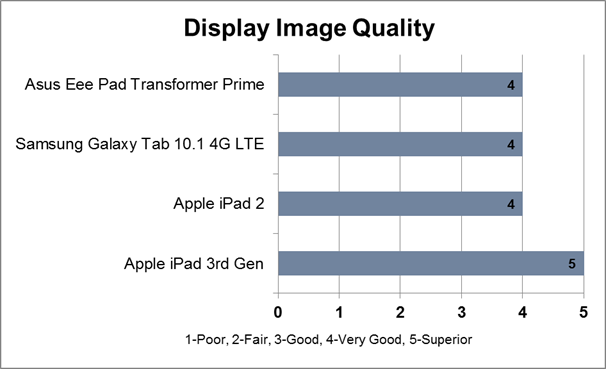
Still, I found the final effects pleasing on the iPad's display: Not only did colors pop and look accurate, but skin tones appeared to be more true-to-life than on the iPad 2 and on any of the Android tablets.
The new iPad's display showed tremendous clarity and detail, and color gradation was finer. On the test photos that PCWorld uses to evaluate every tablet, the new iPad earned marks of Superior across the board. The Asus tablet, by comparison, was too bright, with washed-out whites; and the Samsung tablet exhibited Samsung's propensity to oversaturate images, an issue we've noticed in a number of the company's tablets and phones.
iPad's Pumped-Up Camera
Let's face it: The best camera is the one you have with you; and if you have a tablet on hand, it has the potential to be a great camera because the large display makes framing your shot easy.
The quality of the new iPad's camera sensor has improved dramatically, to the point where images are actually (gasp!) usable. In our blind camera tests for stills and video, the new iPad tied the Asus Transformer Prime for top honors. Those results are especially impressive when you consider that the Prime has an 8-megapixel sensor, whereas the new iPad's carries a 5-megapixel sensor.
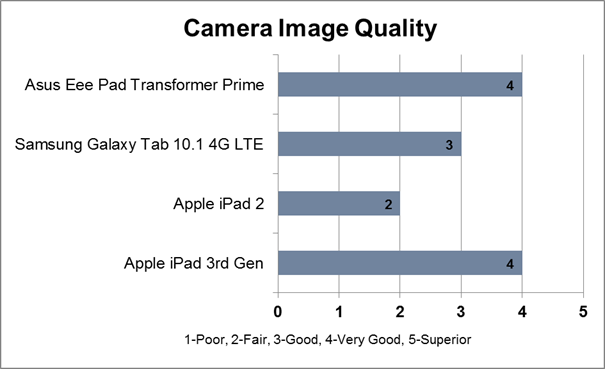
Nevertheless, Apple has plenty of room get better in terms of exposure and noise where the iPad's capture capabilities are concerned. My casually shot video inside an adequately lit corridor was a bit noisier than I'd have liked, but the video was still highly watchable--and superior to video I've captured with competing tablets, except for the Prime. (So far, I've only used the camera indoors for still images; we have yet to see sun this week in San Francisco.)
Just as important, the camera was easy to use and extremely responsive. Even on the Nvidia Tegra 3-based Asus Transformer Prime, the camera app takes its sweet time to focus, capture, and cycle to the next shot. By comparison, the new iPad was bam-bam-bam fast and efficient. I appreciate how Google's Android camera app provides various shooting options in a readily accessible ring, but the camera app's lag is simply intolerable; all too often, by the time it focuses and shoots, I've missed the shot.
The Gaming Connection
The new iPad tore through the GLBenchmark 2.1.2 tests we performed. Admittedly, Synthetic benchmarks account for only part of any performance equation; nonetheless, GLBenchmark provides a useful way to gauge specific components of graphics performance across different platforms.
Here, Apple's new iPad, with its A5X CPU containing two Cortex-A9 processors and a quad-core graphics engine (PowerVR SGX 543MP4), blasted past the competition. On two of four key tests in GLBenchmark, the new iPad virtually tied the iPad 2's performance.
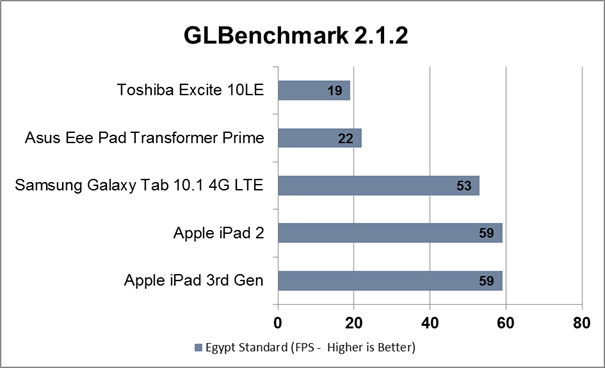
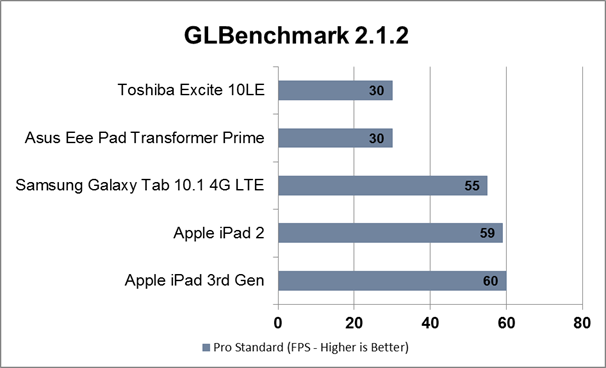
But on two other tests, the new iPad was the clear winner, leaving the iPad 2 and the three Android tablets in the dust. Interestingly, these three Android tablets represent a cross-section of hardware and operating system versions, so it's difficult to isolate why the Android tablets failed to keep up with the iPad's performance on these tests. The Toshiba Excite 10 LE uses Texas Instruments' OMAP 4430, and the Samsung Galaxy Tab 10.1 4G LTE uses Nvidia's Tegra 2; we tested both with Android 3.x Honeycomb. The Asus Eee Pad Transformer Prime, meanwhile, runs Nvidia's Tegra 3 and Android 4.0 Ice Cream Sandwich.
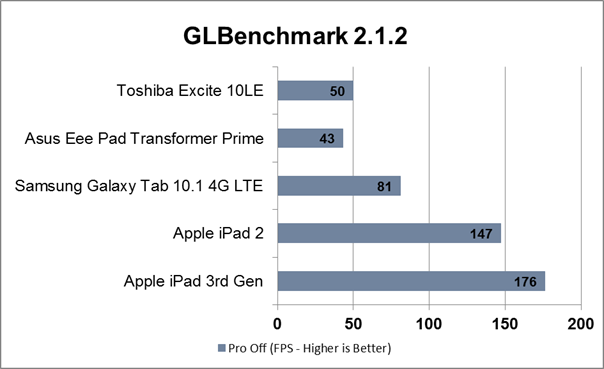
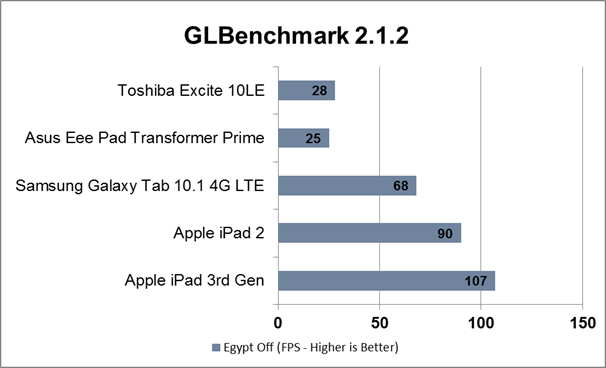
Ultimately, gaming is less about the story that synthetic benchmarks tell and much more about the game software itself. When I tried three games that are available for Nvidia's Tegra 3 and Apple's iPad (but not, specifically, for the third-generation iPad's Retina display), the scale tipped in Nvidia's favor. At least for now, I prefer the experience of playing Riptide GP, ShadowGun, and Sprinkle on the Transformer Prime. In my hands-on testing, the games showed better detail and more-realistic graphics--such as smoke, lighting effects, and motion in a flapping flag--than on the new iPad.
The games did look better on the new iPad than on the iPad 2, but that's not saying much. And games whose graphics weren't optimized for the new iPad didn't wow me; in fact, I was quite disappointed with the experience, including the fact that the games ran just a hair faster (if that) on the new iPad than on the iPad 2. Upscaling can do only so much if the original graphics lack the resolution needed to support the new iPad's pixel-packed display. Games optimized for the Retina--like everything else optimized for the iPad's high resolution--looked great. And the few such games available at launch show why every game maker is going to want to up its graphics game, literally.
I expect the lead that Nvidia's Tegra 3 currently enjoys to be short-lived. Once developers update the graphics in their iPad games--and I'm sure new ones will begin appearing daily--the high-resolution visual experience of gaming on the third-generation iPad will level the playing field all by itself, and perhaps the quad-core graphics engine inside the new iPad will surpass that of the Tegra 3. (We tried to reach the developers for Riptide and ShadowGun to get their feedback on the potential of the new iPad's graphics, but didn't hear back in time for publication.)
Web Surfing
The new iPad did well on our Sunspider load tests, though the Android models had a slight edge on our Web page load tests. These results alone won't sway anyone to or from a third-generation iPad, but they do indicate that, even though Apple's new tablet is a well-rounded package, the company still has areas where it can improve.
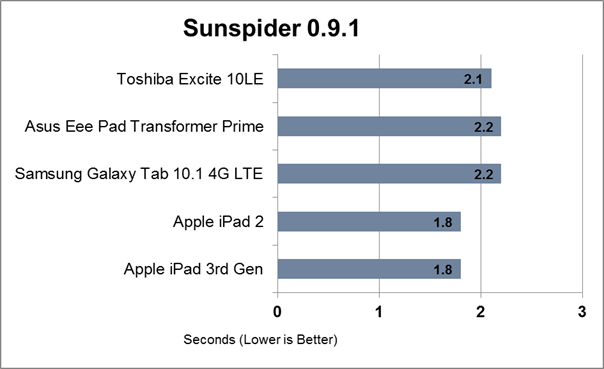
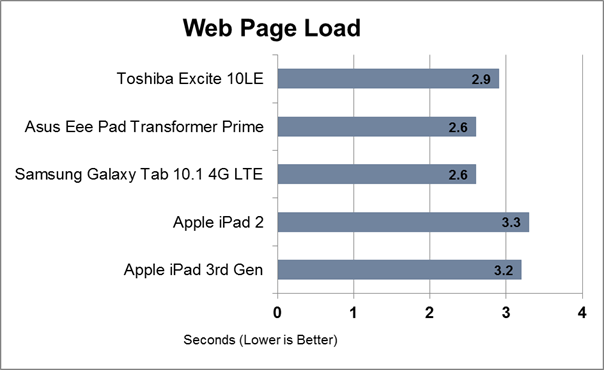
The Android and Windows Tablet Future
It's easy to think, given the effusive praise that critics are lavishing on the new iPad, that the game is over and that the non-Apple contenders should pack up and go home.
Think again.
What the new iPad really means is that the competition must redouble its efforts to challenge the market leader. Apple has clearly extended its competitive advantage with the new iPad, and by lowering the price on the 2011 iPad 2 to $399 for a 16GB Wi-Fi model, Apple has adopted a two-prong approach to maintaining its market dominance.
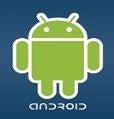 Google and the tablet makers that use Android have a major challenge ahead. Google needs to get serious about addressing the issue of ecosystem fragmentation and the complexities of developing for its Android OS across different hardware. And hardware makers need to double-down on efforts to not only release tablets, but to do something that replicates the "it just works" appeal of Apple's iPad.
Google and the tablet makers that use Android have a major challenge ahead. Google needs to get serious about addressing the issue of ecosystem fragmentation and the complexities of developing for its Android OS across different hardware. And hardware makers need to double-down on efforts to not only release tablets, but to do something that replicates the "it just works" appeal of Apple's iPad.
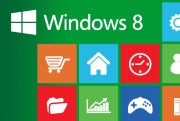 Meanwhile, with the coming onslaught of Windows 8 tablets, Microsoft has a huge opportunity to swoop in and achieve what Google hasn't in the past year. Or does it? Already, the company's introduction of the Windows on ARM variable--meaning that Windows 8 tablets using ARM processors won't support current Windows software--creates an early fork that may invite consumer confusion. Nevertheless, the clean, fresh Metro interface of Windows 8 could be a big win, if Microsoft can get its software ecosystem cranked up to eleven and if hardware makers can come up with distinctive designs that compete with Apple's offerings.
Meanwhile, with the coming onslaught of Windows 8 tablets, Microsoft has a huge opportunity to swoop in and achieve what Google hasn't in the past year. Or does it? Already, the company's introduction of the Windows on ARM variable--meaning that Windows 8 tablets using ARM processors won't support current Windows software--creates an early fork that may invite consumer confusion. Nevertheless, the clean, fresh Metro interface of Windows 8 could be a big win, if Microsoft can get its software ecosystem cranked up to eleven and if hardware makers can come up with distinctive designs that compete with Apple's offerings.
No one knows how successfully Apple's rivals will respond to the challenge posed by the new iPad. But it's going to be fun to watch non-Apple tablets and operating systems as they come to grips with this powerhouse tablet.
This entry passed through the Full-Text RSS service — if this is your content and you're reading it on someone else's site, please read the FAQ at fivefilters.org/content-only/faq.php#publishers. Five Filters recommends: Donate to Wikileaks.
 31/03/2012 - 0 Comments
31/03/2012 - 0 Comments 24/09/2008 - 0 Comments
24/09/2008 - 0 Comments 30/09/2008 - 0 Comments
30/09/2008 - 0 Comments 27/03/2012 - 0 Comments
27/03/2012 - 0 Comments 15/04/2012 - 0 Comments
15/04/2012 - 0 Comments
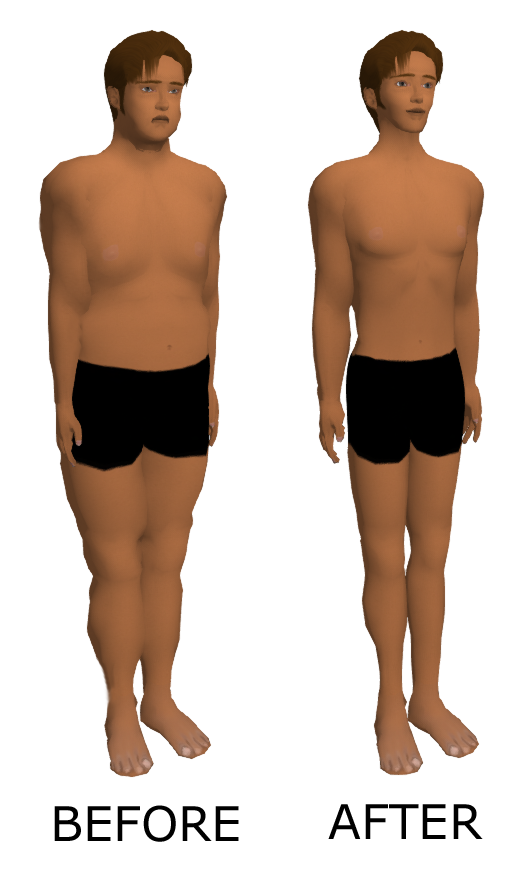












0 意見:
Post a Comment